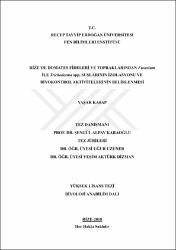| dc.description.abstract | Domates bitkisinde solgunluk, devrilme (kök ve kök boğazı çürüklüğü) hastalıkları etkeni olan Fusarium'lar, ciddi ekonomik kayıplara neden olmaktadırlar. Çalışmamızın amacı, domates fidelerinde solgunluk ve devrilme hastalığı görülen bir bahçede hastalık etkeni mikrofungusların ve potansiyel biyokontrol aktiviteli Trichoderma suşlarının izolasyonu ve karakterizasyonudur. Bu amaçla Rize'nin Pazar ilçesi Kirazlık mahallesinde, hastalıklı sebze bahçesinden 2014-2015 yılları arasında yılda iki kez olmak üzere örnekleme yapıldı. Çalışma kapsamında toplamda 108 izolat elde edildi. Geleneksel tanı yöntemleri ile Ascomycota ve Zygomycota filumuna ait 17 farklı cins belirlendi. Sıklıkla Trichoderma (%24,6), Fusarium (%12,1) ve Mucor (%8,6) cinsleri gözlendi. Trichoderma ve Fusarium cinslerinin tür tanıları, moleküler yöntemlerle teyit edildi. Toplam 13 adet Fusarium'dan en fazla gözlenen tür; F. oxysporum (6) ile F. sambucinum (4), 22 adet Trichoderma'dan ise T. harzianum (%52) ve T. atroviride (%9,5) olduğu belirlendi. Morfolojik özelliklerine göre seçilen Trichoderma (11 adet) suşlarının Fusarium (6adet) suşlarına karşı antagonistik aktiviteleri test edildi. Trichoderma suşlarından 3'ünde (Yp1a, Yp4a ve Yp24b) güçlü antagonistik etkinlik belirlendi. Fusarium suşlarının domates tohumu çimlenmesi üzerine patojeniteleri su agar besiyerinde incelendi. En yüksek patojenik etki ve en düşük vigor indeksi F. sambucinum Yp13b suşunda belirlendi. Trichoderma (Yp1a, Yp4a ve Yp24b) suşlarının domatesin gelişimi üzerine etkinliği incelendi. F. sambucinum Yp13b'nin tohum için patojen ancak domates bitkisi için patojen olmadığı belirlendi. Trichoderma harzianum Yp1a suşunun en etkili biyokontrol ajanı olduğu ve ticari suş olabilme potansiyelinin bulunduğu belirlendi. Fusariums, the factors of the wilt and damping-off (decay in the root and root collar) in the tomato plant cause dramatic economic loss. The aim of our study is the isolation and characterisation of micro fungi, the disease factor in a garden where the wilt and damping-off of the tomato seedlings are observed and the Trichoderma strains that are with potential biocontrol activity. With this intention, from a diseased tomato garden in Kirazlık street, Pazar, Rize, samplings were carried out twice between 2014 and 2015. As part of the study, 108 isolate were obtained in total. Through conventional diagnosis methods, 17 various genus belonging to Ascomycota and Zygomycota filum were specified. Frequently, the genus of Trichoderma (%24,6), Fusarium (%12,1) and Mucor (%86) were observed. The genus diagnosis of Trichoderma ve Fusarium were verified through molecular methods. Of the total 13 Fusariums, the most frequently observed ones were F. oxysporum (6) and F. sambucinum (4), and of the 22 Trichoderma, the most frequently observed ones were T. harzianum (%52) and T. atroviride (%9.5). Selected according to their morphological qualities, Trichoderma (11 pieces) strains antagonistic activities against Fusarium (6 pieces) strains were tested. In the three Trichoderma strains, strong effectiveness (Yp1a, Yp4a and Yp24b) were specified. The pathogeny of Fusarium strains on tomato seeds germination were examined within water agar medium. The highest pathogenic effect and the lowest vigor index were observed to be in F. sambucinum Yp13b strain. The effectiveness of Trichoderma (Yp1a, Yp4a and Yp24b) strains on the development of tomato were examined. F. sambucinum Yp13b was determined to be pathogen for the seed but not for the tomato. Trichoderma harzianum Yp1a was specified as the most efficient biocontrol agent and had the potential to be a commercial strain. | en_US |


















